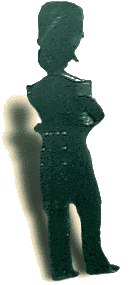Introduction
The Camp at Chalons
under the Second Empire


August 30, 1857 marked a double event.
A military event to inaugurate the opening of a long-awaited camp for large Maneuvers; and
a photographic event with an official commentary commissioned
by the Emperor Napoleon III from the photographer Gustave Le
Gray and painter Benedict Masson :
" These gentlemen had the distinguished honor of residing in the imperial
quarters,
where all had been arranged for their perfect
comfort.
"I have heard it said that S. M. charged these gentlemen with the task of
reproducing, photographically, the principal military scenes for which
the Camp would set the stage, including a
panoramic view of the Camp, picturesque scenes borrowed from
each of the Guard encampments, and portraits of generals and superior
officers, French and foreign, who would stay at the Chalons Camp,
either as commanding officer or as host to the Emperor."
" This collection of photographs will form a magnificent album that
the Emperor will, it is said, present to several generals "
The Musée de l'Armée is in possession of two albums of the Chalons Camp, The Albums Lepic
and Morris are called so after the men to whom they were offered albums. The exhibition is organized around these albums.
The Chalons Camp
Situated at the heart of the region designated Champagne "pouilleuse", fifteen
kilometers north of Chalons-en-Champagne, the camp was
created in 1856 by Napoleon III for training
his armies. Its surface area is 10,000 hectares and its
perimeter measures more than forty kilometers.
After September 15, 1857, it had rail service conncecting it to the Paris-Strasbourg line.
The Roman road from Reims to Bar-le-Duc crosses right through it.
It received 20,000 men in 1857, who were all lodged in tents.
The camp was in operation through the Second Empire, but was
abandoned for a few years after the
French-German war of 1870-1871, and reinvested in by the army of the
Third Republic.
Today it functions under the name of the Mourmelon Camp.
Gustave Le Gray (1820-1884)
The photographs of Le Gray of the Chalons Camp display the life of the
camp in 1857, the prestigious regiments of the Imperial Guard,
the most picturesque also, such as the zouaves whose popularity was
immense under the Second Empire and who lent themselves voluntarily to
the
production before the lens. Le Gray photographed them in a
series of pictures that told of their daily life in the camp.
The flash was not yet perfected, so the painter
Benedict Masson took over for the nighttime scenes
and producing drawings that were photographed and added to the
albums with Le Gray's prints.
The albums of the Chalons Camp
With the exhibition, about fifteen out of the original thirty or so albums were found
and studied, from various public and private collections all over the
world.
The study showed that the albums could be classed in two different series: "small" albums and "large" albums, the latter of which were intended for officers and persons particularly
important or close to the Emperor. These contain a gallery of about
twenty portraits of officers present at the camp in 1857 and a
panorama of the encampments.
The Musée de l'Armée owns one "small album" who recipient was
General Morris (1803-1867), commander of the cavalry division
of the Imperial Guard, and one anomalous album, the Lepic album,
realized without doubt about ten years later for the
Colonel, then General (1865), Jacques Auguste Felix
Lepic (1812-1868), aide-de-camp of the Emperor and commander of the imperial headquarters of the Chalons Camp in
1857. The prints of this album are of excellent quality.
Frederic Lacaille and Florence Le Corre,
commissioners of the exposition

[The Imperial Quarter] [The Zouaves] [Billeting] [Maneuvers] [Mass] [Sculpture at the Chalons Camp] [Nighttime Scenes]